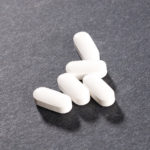By Bonnie Jenkins
I’m one of those people that drug companies hate. I have higher than optimal cholesterol levels, but I can’t take statin drugs—not that I’d want to! Statins like Lipitor and Crestor come with a bevy of potential side effects including cognitive impairment, weakness, dizziness, headaches, insomnia and muscle pain.
Fortunately a recent study backs up the effectiveness of red yeast rice, a centuries-old natural alternative to statin drugs. Red yeast rice is produced when a certain type of yeast, Monascus purpureus, is grown on rice. It has been used in Asian countries for more than a thousand years as both food and medicine. Recently, however, natural health practitioners in the U.S. and Europe have discovered its powerful cholesterol-lowering properties. In one study which appeared in the Annals of Internal Medicine, a group of physicians verified the significant cholesterol-lowering effect of red yeast rice in people who couldn’t tolerate statin drugs.
The study included 62 people who stopped taking statins because of side effects. All of them followed a lifestyle change program that included learning about nutrition, exercise and relaxation techniques. Half also took 1,800 mg. of red yeast rice twice a day, while the others took a dummy pill. The group taking red yeast rice experienced an average drop in cholesterol of 43 points in a mere 12 weeks compared to just 11 points in the placebo group.
The reason red yeast rice works so well is because it contains a small amount of a natural statin called lovastatin. Lovastatin is the same compound found in the prescription drug, Mevacor. But unlike Mevacor, red yeast rice also contains other compounds like plant sterols that might have a positive impact on blocking cholesterol absorption. Researchers have also determined that another ingredient in red yeast rice, called monacolin K, inhibits the production of cholesterol by interfering with HMG-CoA reductase, a key enzyme in the liver responsible for manufacturing cholesterol.
Other studies show that adding fish oil to red yeast rice makes it even more effective. One conducted at the University of Pennsylvania involved 74 people with high cholesterol. Half took 40 mg. of the statin drug Zocor and the other half took 3 grams of fish oil and either 2,400 mg. or 3,600 mg. or red yeast rice for 12 weeks. It turns out that the fish oil-red yeast rice combo was just as effective as the statin.
But, even though red yeast rice is natural, it can still impact the liver to some degree. That’s why it’s important to have your liver function checked periodically. And like statins, red yeast rice may also inhibit the natural synthesis of coenzyme Q10 (CoQ10), which is needed for optimum heart health and general health. Whether you take red rice yeast extract or statins, be sure to take 90 to 120 mg. of CoQ10 every day.
The World's Quickest Solution for Ending Prostate and Urinary Misery
This has recently been revealed to be one of the only real breakthroughs in prostate health.
The seeds of a strange fruit (sometimes called "Chinese Apples") hold powerful phytonutrients that are a revolution in prostate health.
In fact, UCLA and Veterans Administration research have now proved this to be true.
Not only that, but it may be the worlds quickest solution for ending prostate misery.
Simply stated, these phytonutrients represent a huge step beyond beta sitosterol, saw palmetto, and other phytosterols alone.
Simply click HERE if you want to have fast prostate relief...restful, uninterrupted sleep...no more constant "urges to go"...enhanced virility...and optimal prostate support for life.
Just be aware that red yeast rice is just one more tool in the battle to lower unhealthy cholesterol levels. Along with adding red yeast rice, fish oil and CoQ10 to your daily supplement regime, it’s also important to adopt the following habits to help your cholesterol under control:
- Be sure to get at least 30 minutes of aerobic exercise every day.
- Eat a diet high in antioxidant-rich fruits and vegetables.
- Include fatty fish like salmon at least twice a week.
- Keep your saturated fat intake low—no more than five percent of your daily caloric intake.
- Minimize the consumption of quick-digesting (high glycemic load) carbohydrates, especially products containing white flour and white sugar.
- Increase your consumption of soluble fiber, the kind found in oat bran.
- Eat garlic, hot chili peppers and shiitake mushrooms frequently.
- Try to drink at least three cups of green tea daily.
All of these actions may seem small when your think about them individually, but when you take them together, you’ll be surprised at the beneficial impact they can have on your cholesterol levels. No drugs required!
References:
Becker DJ, et al. Red Yeast Rice for Dyslipidemia in Statin-Intolerant Patients: A Randomized Trial. Annals of Internal Medicine. 2009; 150: 830-839.
Becker DJ, et al. Simvastatin vs therapeutic lifestyle changes and supplements: randomized primary prevention trial. Mayo Clinic Proceedings. 2008;83:758-764.
Yang HT, et al. Acute administration of red yeast rice (Monascus purpureus) depletes tissue coenzyme Q(10) levels in ICR mice. British Journal of Nutrition. 2005;93:131-135






